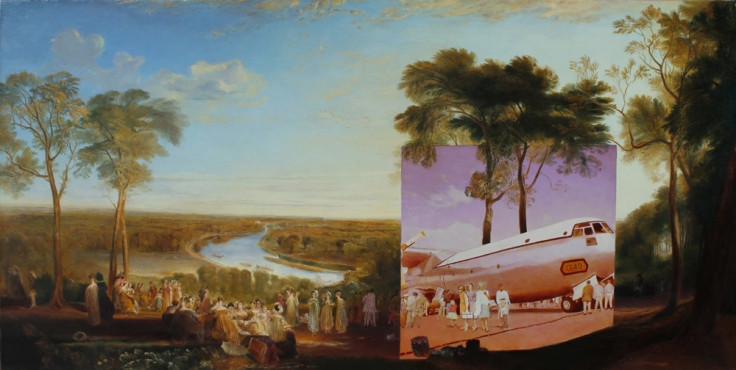“I think we invent. We make up our own mythology about our past quite often without even realising it, and those moments were not all that fantastic.” So says Morwenna Morrison on the subject of nostalgia, the central theme of her work in a new two-handed exhibition with fellow artist Andrew McIntosh at London’s James Freeman Gallery. In their different ways, both artists merge past and present, giving familiar landscapes an enigmatic twist.
Morwenna Morrison studied Fine Art at Exeter College of Art and Design has shown at numerous solo and group exhibitions including at The Art pavilion in London and the Arusha Gallery in Edinburgh. Her landscapes here are based on the 17th century French artist Claud Lorrain whose idealised scenes looked back to “golden times”. He influenced many subsequent painters including JMW Turner, as well as the great landscape architect Capability Brown. Morrison then questions and confronts the mythology, creating a collision of images from different eras.
In Contemplating Ehrenbreitstein, above, you may recognise the Turner painting she has copied as the background on which she has imposed a 1960s photograph-style painting. At first glance, it might seem like collage but it has, in fact, been cleverly connected via the trees and the lake. It’s through old photos that most of us evoke nostalgia these days.

Similarly, with An Infinite Summer she uses another well-known Turner painting of Richmond Park for transplanting a 1950s airliner that’s linked via the tree root, the trees and the figures, yet retaining that polaroid picture look. Once again she’s recreating two different eras that are both backward looking. “You realise that all those people have died in the painting there, so there’s an evocation of sadness, and when you look at your own photographs, you’re looking for your youth as well.”
The people are made to appear as if they’re getting on the plane to enhance the idea of a nostalgic continuum. The scene caused the artist some mirth. “I discovered that Richmond Park is on the Heathrow flypath so it could be slightly political because people are up in arms about having more planes going over,” she says, smiling.

There’s a harder political edge to Et In Arcadia Ego in which a lush, over-romanticised landscape is interrupted by a monochrome photo-style depiction of a native American standing before her teepee. Once again, the trees connect these two scenes from different eras. The landscape is taken from Hendrik Voogd, known as the Dutch Claude Lorrain.
“I chose a native American specifically because when you look at her, although she is smiling, for a westerner it evokes guilt and sadness,” says Morrison referring to the fact that, never mind the wars, westerners wiped out most of the native American population mostly from the diseases they brought with them to which the locals had no immunity. The landscape therefore represents the west and so gives it a kind of oppressive connotation that subtracts from its over-romanticised effect.

Andrew McIntosh, or Mackie as he signs his works, paints landscapes too. He’s a prize-winning painter whose work is to be found in many important collections and has exhibited at the Royal Academy. In the painting above, the mist rolls down between the hills above Loch Carron in the Scottish Highlands from where McIntosh hails. However, the island looks like it’s been plugged into the mains electricity grid. “I don’t know what’s going on”, he tells me. “I just thought it would be nice to build a composition of Loch Carron but I wanted to put some form of electric charge into this, one that sparks, just to see what would happen.” Well, what happens is you get this contrast between light and dark, tranquility and disturbance, a strange balance that’s both curious and unnerving. “I broke free of romanticism a while ago,” he adds with a smile.
Lightning strikes on trees, islands and buildings are a key motif in McIntosh’s paintings here. He revels in placing incongruous images together. He takes an old train, for example. in which part of the carriage is given over to a star chart as if this would help the driver navigate his journeys going backwards and forwards on a track!

Three of his paintings are of caravans where the astronomical idea gets more complex. His mother owned two caravans which he used to help clean when he was a kid, so they have a friendly connotation for him. In Agent of Vega which along with Agent of Altair and Agent of Dener make up what astronomers call the Summer Triangle, McIntosh has given over part of the interiors to the relevant star chart. The caravan is stuck on a beach before an impending storm.
“Having a dark stormy beach and putting a friendly shape on it and putting it in this potentially dangerous stormy environment is balancing the emotions of it all. I’m trying to give something that is maybe scary, trying to give you something that’s maybe friendly, then trying to fit something inside it that might interest you.”

Again, with The Machine, you get this incongruous contrast between this bizarre contraption which is a Victorian bathing machine, friendly enough I suppose, with the lightning striking outside. Part of its interior forms a futuristic computer room, the last thing you’d expect to see, especially if you were a Victorian bather. It’s actually based on the room in Kubrick’s 2001 A Space Odyssey which the computer HAL doesn’t want you to enter as it’s where you could shut him down. So once again you have a cryptic puzzle with a balance of emotions.
As with Morrison’s pictures, there’s plenty here to stir the emotions and keep you thinking and guessing. There’s a certain mystery in the paintings that shatters their romantic illusion.
Just Putting It Out There is showing at the James Freeman Gallery, 354 Upper Street, Islington London N1 0PD until 23 June 2018
All images are used with the permission of the artists and gallery.

Leave a comment